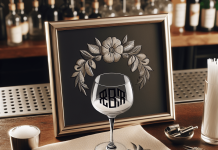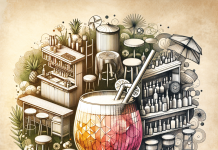When it comes to enjoying a refreshing cocktail, the question of how many ounces it should be is one that often arises. In this article, we aim to shed light on this common query, exploring the factors that can influence the ideal size of a cocktail. From the type of drink to personal preferences, we delve into the considerations that can help you determine the perfect amount of liquid to savor in your favorite cocktail. So, if you’ve ever wondered if your drink is too full or lacking in quantity, read on to uncover the secrets behind the optimal ounce count for a truly delightful cocktail experience.
The Standard Cocktail Size
Definition of a Standard Cocktail Size
When it comes to enjoying a cocktail, the size matters. The standard cocktail size refers to the predetermined volume of liquid served in a single cocktail. It provides a consistent experience for both the customer and the bartender, ensuring that each drink is made with the same precision and attention to detail. While there may be slight variations depending on the cocktail, understanding the ideal standard size is crucial to maintaining quality and consistency in the world of mixology.
Reasons for Standardizing Cocktail Sizes
The standardization of cocktail sizes serves several important purposes. Firstly, it allows for efficient service in busy bars. With a predetermined volume for each cocktail, bartenders can quickly make drinks without the need for excessive measuring or wasted ingredients. Additionally, standard sizes help to control alcohol consumption, ensuring that each drink contains a consistent amount of liquor. This is particularly important when it comes to responsible serving and preventing overconsumption. Finally, standardized cocktail sizes promote accurate pricing, allowing customers to know exactly what they are paying for and ensuring fair pricing across different establishments.
Standard Cocktail Sizes in Different Countries
Different countries often have their own variations of standard cocktail sizes. For example, in the United States, a standard cocktail is typically around 1.5 to 2 ounces (44 to 59 mL) of alcohol, while in the United Kingdom, it is more commonly 25 mL. In Australia, the standard is usually 30 mL. These variations can be attributed to cultural differences, historical influences, and legal regulations. Despite these differences, bartenders and patrons alike can appreciate the importance of adhering to a standard size, regardless of where they are enjoying their cocktail.
Factors Affecting Cocktail Size
Alcoholic Content
The alcoholic content of a cocktail plays a significant role in determining its size. Cocktails with a higher alcohol concentration, such as those served straight up or on the rocks, are generally smaller in size. This is to prevent overconsumption and to accommodate the stronger taste and effects of the alcohol. In contrast, cocktails with a lower alcohol content, such as fruity or sweet mixed drinks, are often served in larger sizes to provide a more refreshing and less potent experience.
Glassware
The choice of glassware for serving cocktails can greatly influence their size. Different glass shapes and sizes may be used to enhance the presentation of a cocktail or to accommodate specific ingredients and garnishes. For example, a tall Collins glass may be used for a mojito, allowing room for ice, mint sprigs, and a straw, while a martini glass is smaller and more streamlined, designed to showcase the drink’s elegance and aroma. Bartenders must consider the appropriate glassware for each cocktail to ensure the ideal visual impact and overall drinking experience.
Ingredients
The ingredients used in a cocktail also play a role in determining its size. Some cocktails require larger volumes due to the inclusion of mixers, juice, or other non-alcoholic components. For example, a margarita typically contains a combination of tequila, lime juice, and orange liqueur, necessitating a larger size to accommodate these ingredients. On the other hand, classic cocktails like a negroni or an old-fashioned rely on a few key spirits mixed together, allowing for a smaller, more concentrated serving size.
Presentation
Last but certainly not least, the presentation of a cocktail can influence its size. Many contemporary and signature cocktails incorporate creative presentations, such as layered or multi-component compositions. These artistic displays often call for smaller portions to maintain the desired ratio and visual appeal. On the other hand, classic cocktails typically have more straightforward presentations, allowing for slightly larger sizes. Bartenders must consider both the taste and visual aspects of a cocktail when determining its appropriate size.
Historical Background
Evolution of Cocktail Sizes
The history of cocktail sizes is deeply intertwined with the evolution of cocktail culture itself. In the early days of cocktails, dating back to the 19th century, drinks were generally smaller in size, with classic recipes often calling for 1 to 2 ounces of alcohol. This was due to the relatively high alcohol content of the spirits used and the desire for more concentrated flavors. Over time, as the cocktail scene expanded and bartenders began experimenting with new ingredients and mixers, larger-sized cocktails emerged to accommodate these additions and provide a more refreshing experience.
Prohibition Era and its Effects on Cocktail Sizes
The Prohibition era in the United States, from 1920 to 1933, had a significant impact on cocktail sizes. As the production, sale, and consumption of alcohol were prohibited, people turned to speakeasies, underground establishments that illegally served cocktails. To hide the taste and smell of bootlegged alcohol, bartenders often mixed it with fruit juices, syrups, and other ingredients, resulting in larger-sized cocktails that masked the lower quality and harshness of the spirits. This clandestine period in cocktail history led to the rise of sweeter, larger-sized drinks that became popular even after Prohibition ended.
Trends in Cocktail Size Over Time
Cocktail sizes have experienced fluctuating trends over time, influenced by changing palates, cultural shifts, and innovations in mixology. In recent years, there has been a resurgence of interest in classic cocktails, which has seen a return to smaller, more refined serving sizes reminiscent of the golden age of cocktails. This trend embraces the appreciation for the quality and craftsmanship of each ingredient, presenting cocktails as an art form rather than just a means of intoxication. Additionally, the growing interest in craft cocktails has also led to a focus on balance and precision, resulting in smaller, more measured serving sizes.
Different Types of Cocktails
Classic Cocktails
Classic cocktails are timeless creations that have stood the test of time and are still enjoyed today. Cocktails such as the martini, old-fashioned, and negroni fall into this category. These drinks often feature simple yet powerful combinations of spirits, bitters, and a touch of sweetness. Classic cocktails are typically served in smaller sizes, allowing the flavors to shine through without dilution or excess volume.
Contemporary Cocktails
Contemporary cocktails represent the evolution of mixology, showcasing innovative techniques, unique flavor combinations, and modern twists on traditional recipes. These drinks often incorporate unusual ingredients, house-made infusions, or unexpected presentations. Contemporary cocktails can vary in size depending on the specific recipe and the desired experience. Some may be smaller to highlight the intricacy of the flavors, while others may be larger to accommodate elaborate garnishes and theatrical presentations.
Signature Cocktails
Signature cocktails are unique creations crafted by individual bartenders or establishments. These drinks often reflect the personal style and creativity of the mixologist and are designed to showcase the bar’s identity. Signature cocktails can come in a range of sizes depending on the preferences and vision of the creator. Some may be smaller to maintain consistency with the standard cocktail size, while others may be larger to make a bold statement or provide a shared drinking experience.
Popular Cocktail Sizes
Martini
The martini is a classic cocktail known for its elegance and simplicity. Traditionally made with gin and vermouth, the martini is typically served in a 3 to 4-ounce glass. The smaller size allows for a higher concentration of flavors, emphasizing the botanical notes of the gin and the delicate balance of sweetness and dryness. While some variations may call for larger sizes, the classic martini is best enjoyed in its smaller, more concentrated form.
Margarita
The margarita is a beloved tequila-based cocktail that is synonymous with fun and relaxation. This refreshing drink is commonly served in a 6-ounce glass, allowing room for a mixture of tequila, lime juice, and other ingredients such as orange liqueur or agave syrup. The larger size of the margarita accommodates the need for a balanced ratio of flavors, ensuring each sip is a harmonious blend of tangy citrus, smooth tequila, and a touch of sweetness.
Cosmopolitan
The cosmopolitan, made famous by its association with the television show “Sex and the City,” has a reputation for being a stylish and sophisticated drink. This vodka-based cocktail is often served in a 4-ounce glass, striking a balance between small and medium-sized cocktails. The cosmopolitan’s size allows for the infusion of cranberry juice, lime juice, and orange liqueur, creating a harmonious blend of fruity and citrus flavors without overwhelming the drinker.
Old-Fashioned
The old-fashioned is a classic cocktail that has remained virtually unchanged for generations. Made with whiskey, sugar, and bitters, this drink is typically served in a 4 to 6-ounce glass. The larger size of the old-fashioned allows for the inclusion of a sugar cube or simple syrup, which needs to be muddled with the bitters to create the cocktail’s distinct sweetness and aroma. The additional volume ensures that each sip is a perfectly balanced combination of spirit, sweetness, and aromatic complexity.
Mojito
The mojito is a refreshing rum-based cocktail that has gained worldwide popularity for its tropical flair. This drink is usually served in an 8 to 10-ounce glass, offering ample space for muddled mint leaves, lime juice, simple syrup, and soda water. The larger size of the mojito allows for a generous amount of ice, ensuring a well-chilled and thirst-quenching experience, perfect for hot summer days or lively social gatherings.
Negroni
The negroni is a timeless Italian cocktail known for its bold and bitter profile. Made with equal parts gin, Campari, and sweet vermouth, this drink is typically served in a 3 to 4-ounce glass. The smaller size of the negroni allows for a more concentrated flavor, as the combination of potent spirits and bitter Campari requires a smaller volume to achieve balance. The negroni’s size reflects its intensity and sophistication, providing a full-flavored experience in every sip.
Manhattan
The Manhattan is a classic whiskey cocktail with a rich history and a refined taste. Traditionally made with rye whiskey, sweet vermouth, and bitters, the Manhattan is typically served in a 3 to 4-ounce glass. The smaller size allows for the careful layering of flavors, balancing the boldness of the whiskey with the sweetness of the vermouth and the complexity of the bitters. The smaller serving size ensures that the Manhattan remains a sophisticated and potent drink, best enjoyed in moderation.
Importance of Standardized Cocktail Sizes
Consistency in Taste
One of the key benefits of standardized cocktail sizes is the consistency in taste they provide. When patrons order a cocktail, they have certain expectations regarding the flavor, balance, and overall experience. By adhering to specific sizes, bartenders can ensure that each drink is made with precise measurements, resulting in a consistent taste that customers can rely on. This consistency builds trust and encourages patrons to return to their favorite establishments for the familiar and enjoyable cocktail experience.
Efficient Service
In a fast-paced bar environment, efficiency is crucial. Bartenders need to be able to quickly and accurately fulfill drink orders without sacrificing quality. By standardizing cocktail sizes, drink preparation becomes more streamlined, eliminating the need for excessive measuring or guesswork. This allows bartenders to serve a larger volume of customers in a timely manner, ensuring everyone has a positive and efficient bar experience.
Controlling Alcohol Consumption
Standardized cocktail sizes play an important role in responsible alcohol serving. By adhering to predetermined volumes, bartenders can control the amount of alcohol served to each customer. This promotes responsible drinking habits and helps prevent overconsumption, ensuring the safety and well-being of patrons. With alcohol-related issues a concern in many countries, standardized cocktail sizes provide a valuable tool in maintaining a balanced and responsible drinking culture.
Accurate Pricing
Standardized cocktail sizes also facilitate accurate pricing. Customers should have a clear understanding of what they are paying for when they order a cocktail. By maintaining consistent sizes, bars and restaurants can establish fair and transparent pricing structures. Patrons can make informed decisions about their purchases, knowing that they are paying for a specific volume of ingredients and the expertise of the bartender. Accurate pricing encourages trust between establishments and customers, leading to a healthier and more sustainable business environment.
Challenges in Determining Cocktail Size
Varying Recipes
One of the challenges in determining cocktail size is the wide range of recipes available. Each cocktail has its own unique combination of ingredients and proportions, meaning that a standardized size may not suit every recipe. For example, some cocktails with complex flavor profiles may require larger sizes to accommodate multiple ingredients and maintain the desired balance. Balancing consistency and variety is a challenge that bartenders face when determining the appropriate size for each cocktail.
Personal Preferences
Another challenge is the personal preferences of both bartenders and customers. Some individuals may prefer larger-sized cocktails to ensure a longer and more leisurely drinking experience, while others may prefer smaller sizes for a more concentrated and refined taste. Balancing these preferences while adhering to industry standards can be a delicate task, requiring a deep understanding of the desired outcome and the expectations of both the bartender and the customer.
Cultural Differences
Cultural differences also pose a challenge in determining cocktail sizes. Different regions and countries have their own drinking cultures and expectations. For example, in some countries, stronger and more potent drinks are favored, leading to larger-sized cocktails. In contrast, other cultures may prioritize the balance of flavors and prefer smaller, more concentrated servings. Bartenders must navigate these cultural nuances when determining the appropriate size for each cocktail.
Varied Glassware
The choice of glassware can greatly impact the perceived size of a cocktail. Different glass shapes and sizes can create the illusion of a larger or smaller serving, even if the volume of liquid remains consistent. For example, a cocktail served in a tall and narrow Collins glass may appear larger than the same amount of liquid served in a short and wide rocks glass. Bartenders must consider the optical effects of different glassware to ensure that the presentation and perceived size align with the standard for each cocktail.
Cocktail Size Recommendations
Industry Standards
For institutions and organizations seeking to establish cocktail size standards, industry guidelines can provide valuable recommendations. Organizations such as the International Bartenders Association (IBA) and the United States Bartenders’ Guild (USBG) offer guidance on accepted cocktail sizes based on historical precedence, industry experience, and customer expectations. These standards can serve as a starting point for establishments looking to create consistency in their cocktail offerings and ensure a quality experience for their patrons.
Bartenders’ Expertise
While industry standards can provide a useful framework, the expertise of bartenders is also essential in determining the appropriate size for each cocktail. Experienced mixologists have an intimate understanding of the ingredients, flavors, and presentation of their craft. They can assess the individual characteristics of each cocktail and adapt the size accordingly to create the desired experience. Bartenders bring a level of artistry and intuition to the process, using their knowledge and skill to determine the ideal size for each cocktail they create.
Effects of Cocktail Size on the Drinking Experience
Balance of Flavors
Cocktail size can have a significant impact on the balance of flavors within a drink. Smaller-sized cocktails allow for a more concentrated combination of ingredients, ensuring each flavor shines through without dilution. This is particularly important for cocktails with delicate nuances and complex flavor profiles, as the smaller volume preserves their integrity. Larger-sized cocktails, on the other hand, can provide a more rounded and harmonious taste, allowing the flavors to mingle and integrate over time.
Chilling Rate
The size of a cocktail can influence its chilling rate. Smaller-sized cocktails tend to chill more quickly, as a larger surface area of the liquid is exposed to the ice. This rapid chilling can be desirable for certain cocktails that benefit from being served at a lower temperature, such as martinis or other drinks that feature delicate spirits. Larger-sized cocktails, while still chilled, may take longer to reach an optimal drinking temperature, allowing the consumer to savor the flavors at a more leisurely pace.
Aesthetic Appeal
Cocktail size also plays a role in the aesthetic appeal of a drink. The presentation of a cocktail can greatly enhance the overall drinking experience, and size is a key component of that presentation. A smaller-sized cocktail served in an elegant glass can create an air of sophistication and refinement, while a larger-sized cocktail presented with vibrant garnishes can evoke a sense of celebration and abundance. Bartenders must carefully consider the desired visual impact when determining the appropriate size for each cocktail.
Conclusion
Finding the right balance when it comes to cocktail sizes is essential in the world of mixology. By understanding the definition and importance of standard cocktail sizes, and considering the factors that affect size, bartenders and establishments can create a consistent and enjoyable drinking experience for their patrons. Despite the challenges posed by varying recipes, personal preferences, cultural differences, and varied glassware, the industry has established guidelines and the expertise of bartenders to guide the determination of cocktail sizes. Whether it’s a classic cocktail, a contemporary creation, or a signature drink, the appropriate size can enhance the balance of flavors, control alcohol consumption, promote efficient service, and contribute to the overall enjoyment of each cocktail. So, next time you sip on your favorite drink, take a moment to appreciate the careful consideration given to its size, ensuring that every cocktail is crafted with quality and precision. Cheers to finding the perfect-sized cocktail for every occasion!








































